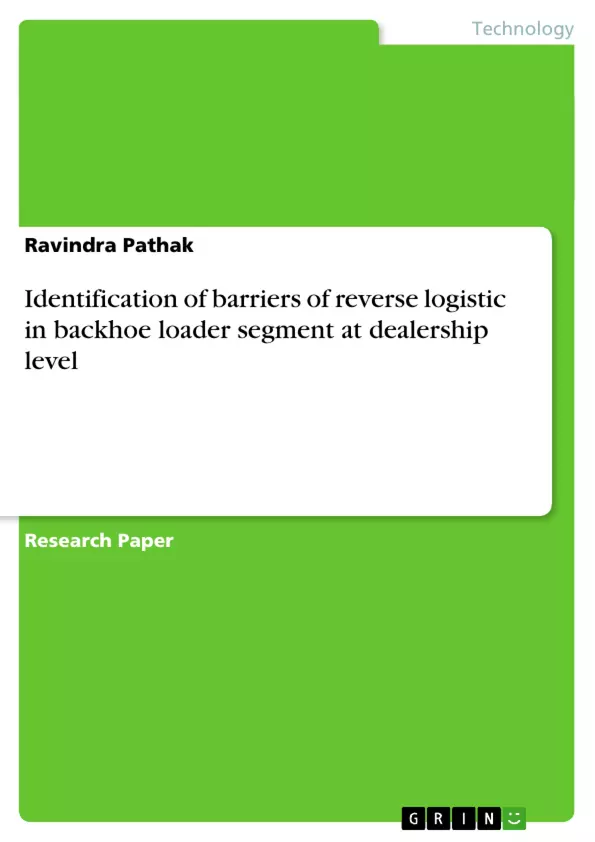Reverse Logistics deals with the processes associated with the reverse stream from users/owners to re-users. The carrying back of goods sold to the market has grown to be an important area of the logistics system. The aim of this paper is to propose a framework & identify the barriers of reverse logistic for backhoe loader segment in dealership for a reverse logistics system. This paper is mainly concentrated to the backhoe loader industry, which is a Separate segment within the construction equipment industry. The construction equipment market is categorized into three segments; heavy equipment, compact equipment and the backhoe loader (BHL). The BHL segment has grown rapidly during the years and is today the fourth largest in the world, with annual sales of about 4000 products. The market for BHL is predicted to continue to grow by 6-8% for the next two to three years. The market share for high technology and quality products is expected to increase as a part of total sales. The backhoe loader Market in India is the fourth largest in the world and the attention from all the major global actors has increased in recent years, mainly due to the reforms of privatization, liberalization and the huge potential in the market. There are a number of specifics typical for the Indian market, such as high price sensitivity due to the constant alternative of the low cost labor, and additionally the heavy usage of products, which are not likely to be found in other more developed markets. In order for JCB India to build long-term relationships with customers, trust and commitment are key factors. Additionally, this paper includes an in-depth analysis of operation and the barrier of reverse logistic in this segment.
Inhaltsverzeichnis (Table of Contents)
- 1. Introduction
- 2. Methodology
- 2.1 Objective of the Study
- 2.2 Introduction to the Organization
- 2.3 Reverse logistic system:
- 2.4 Backhoe Loader:
- 2.5 Reverse logistic system in dealership
- 3. Identified barriers of reverse logistic in dealership
- 3.1 Lack of information and technological systems
- 3.2 Problems with product quality
- 3.3 Company policies
- 3.4 Resistance to change to reverse logistics
- 3.5 Lack of appropriate performance metrics
- 3.6 Lack of training and education
- 3.7 Financial constraints
- 3.8 Lack of commitment by top management
- 3.9 Lack of awareness about reverse logistics
- 3.10 Lack of strategic planning
- 3.11 Reluctance of the support
- 4. Consecutive losses due to these barriers:
Zielsetzung und Themenschwerpunkte (Objectives and Key Themes)
This paper aims to analyze and identify the barriers to reverse logistics within the backhoe loader segment at a dealership level, with a focus on the JCB India Limited dealership, Bhopal Motors Limited. It proposes a framework to understand these barriers and their potential consequences.
- Reverse logistics practices in the construction equipment industry, particularly backhoe loaders
- Identification of barriers hindering the implementation of effective reverse logistics programs
- Analysis of the impact of these barriers on operational efficiency and financial performance
- Exploration of the role of information systems, company policies, and managerial commitment in promoting reverse logistics
- Highlighting the importance of awareness, strategic planning, and training for successful reverse logistics implementation
Zusammenfassung der Kapitel (Chapter Summaries)
The paper starts by introducing the concept of reverse logistics, emphasizing its growing importance in the current business environment. The study focuses on the backhoe loader segment, a rapidly growing market in India. The paper then outlines the methodology used, including the primary and secondary objectives of the study and a brief introduction to the organization. It delves into the specific reverse logistics system in place at the dealership, describing the various steps involved from customer complaint to reimbursement of warranty claims.
The core of the paper lies in identifying and analyzing the various barriers to reverse logistics at the dealership level. These include a lack of information systems, issues related to product quality, restrictive company policies, resistance to change, inadequate performance metrics, and a lack of training and education. Each barrier is discussed in detail, highlighting its impact on the overall reverse logistics process.
The paper concludes by examining the consequences of these barriers, including losses in warranty claims and potential disruptions to operational efficiency. The study emphasizes the need for addressing these barriers to achieve successful reverse logistics implementation in the backhoe loader segment. This requires a multi-faceted approach involving technological improvements, policy adjustments, managerial commitment, and increased awareness about the benefits of reverse logistics.
Schlüsselwörter (Keywords)
This paper focuses on the analysis of reverse logistics barriers in the backhoe loader segment at a dealership level. It explores key concepts like information systems, product quality, company policies, resistance to change, performance metrics, training and education, financial constraints, managerial commitment, and awareness. The study aims to contribute to the understanding of reverse logistics challenges in the construction equipment industry and provides insights into potential solutions for improving operational efficiency and financial performance.
- Citation du texte
- Ravindra Pathak (Auteur), 2007, Identification of barriers of reverse logistic in backhoe loader segment at dealership level, Munich, GRIN Verlag, https://www.grin.com/document/89890



